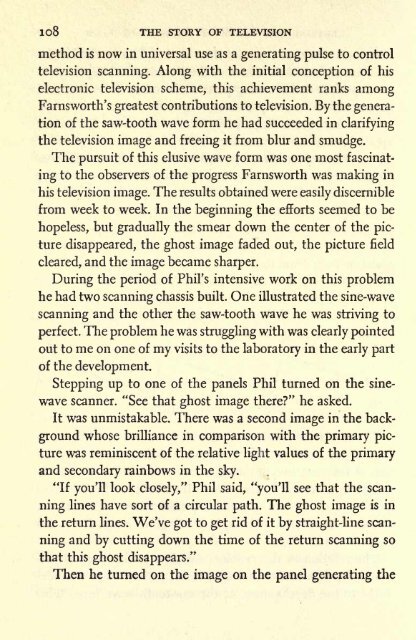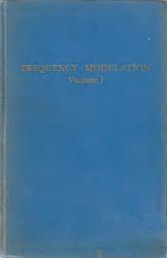the life of Philo T Farnsworth - Early Television Foundation
the life of Philo T Farnsworth - Early Television Foundation
the life of Philo T Farnsworth - Early Television Foundation
Create successful ePaper yourself
Turn your PDF publications into a flip-book with our unique Google optimized e-Paper software.
1O8<br />
THE STORY OF TELEVISION<br />
method is now in universal use as a generating pulse to control<br />
television scanning. Along with <strong>the</strong> initial<br />
conception <strong>of</strong> his<br />
electronic television scheme, this achievement ranks among<br />
<strong>Farnsworth</strong>'s greatest contributions to television.<br />
By <strong>the</strong> generation<br />
<strong>of</strong> <strong>the</strong> saw-tooth wave form he had succeeded in clarifying<br />
<strong>the</strong> television image and freeing it from blur and smudge.<br />
The pursuit <strong>of</strong> this elusive wave form was one most fascinating<br />
to <strong>the</strong> observers <strong>of</strong> <strong>the</strong> progress <strong>Farnsworth</strong> was making in<br />
his television image. The results obtained were easily discernible<br />
from week to week. In <strong>the</strong> beginning <strong>the</strong> efforts seemed to be<br />
hopeless, but gradually <strong>the</strong> smear down <strong>the</strong> center <strong>of</strong> <strong>the</strong> picture<br />
disappeared, <strong>the</strong> ghost image faded out, <strong>the</strong> picture field<br />
cleared, and <strong>the</strong> image became sharper.<br />
During <strong>the</strong> period <strong>of</strong> Phil's intensive work on this problem<br />
he had two scanning chassis built. One illustrated <strong>the</strong> sine-wave<br />
scanning and <strong>the</strong> o<strong>the</strong>r <strong>the</strong> saw-tooth wave he was striving to<br />
perfect. The problem he was struggling with was clearly pointed<br />
out to me on one <strong>of</strong> my visits to <strong>the</strong> laboratory in <strong>the</strong> early part<br />
<strong>of</strong> <strong>the</strong> development<br />
Stepping up to one <strong>of</strong> <strong>the</strong> panels Phil turned on <strong>the</strong> sinewave<br />
scanner. "See that ghost image <strong>the</strong>re" he asked.<br />
It was unmistakable. There was a second image in <strong>the</strong> background<br />
whose brilliance in comparison with <strong>the</strong> primary picture<br />
was reminiscent <strong>of</strong> <strong>the</strong> relative light values <strong>of</strong> <strong>the</strong> primary<br />
and secondary rainbows in <strong>the</strong> sky.<br />
"If you'll look closely," Phil said, "you'll see that <strong>the</strong> scanning<br />
lines have sort <strong>of</strong> a circular path. The ghost image is in<br />
<strong>the</strong> return lines. We've got to get rid <strong>of</strong> it<br />
by straight-line scanning<br />
and by cutting down <strong>the</strong> time <strong>of</strong> <strong>the</strong> return scanning so<br />
that this ghost disappears."<br />
Then he turned on <strong>the</strong> image on <strong>the</strong> panel generating <strong>the</strong>











